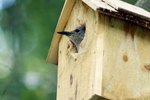Things You'll Need
Welded wire, 14-gauge, 1-inch by 2-inch mesh, 24 inches high
Welded wire, 14-gauge, 1/2-inch by 1-inch mesh, 24 inches high
Tape measure
Wire cutter
J-clips
J-clip pliers
Finger loop springs, one per cage built
Rubber or plastic door guard
Work gloves (optional, but recommended)
Small flocks of poultry are traditionally kept in backyard coops, with or without runs. However, sometimes it becomes necessary to use wire cages to keep your flock safe, healthy and happy. Each of these cages should provide ample room for a single large fowl chicken or for a pair of bantams.
Measure and cut the larger mesh wire. Cut three pieces that are 36 inches long and two pieces that are 18 inches long. Cut a piece that's 16-inches by 16-inches for the door. Set these pieces aside.
Measure and cut one piece of the smaller mesh wire, 36 inches long.
Place the 24-inch side of one 18-inch by 24-inch piece flush against the 24-inch side of one 36-inch, large mesh piece. Use the j-clip pliers and j-clips, placed two inches apart, to connect the pieces. Repeat the process at the opposite end. Make certain all of the j-clips are tightly closed, preventing any movement or gaps between the pieces.
Attach another 36-inch, large mesh piece to the free sides of the smaller pieces of wire. Use the j-clip pliers and j-clips, placed two inches apart, to connect the pieces. The cage should now be an open rectangle.
Place the final 36-inch, large mesh piece on top of the open rectangle. Attach this piece using the same method as before.
Turn the cage over. Attach the remaining 36-inch piece of wire mesh in the same fashion as before, closing the rectangle.
Measure an area 15 inches by 16 inches on the cage front. This will be the area for your cage door. You can place your door wherever you wish; however, a centered placement is recommended. Cut the opening.
Center your prepared door piece over this opening. Attach the door to the cage using j-clips as before; however, these clips should be loosely clamped to allow the door to move.
Cover the door edges with door guards. Attach the finger hook spring to the center of the top of your door. This spring will be your latch. Ensure that the placement of the spring will allow the hook to reach an opening in the mesh and that it will hold the door securely closed.
Tips
These cages can also be used to house gamebirds, such as quail .
Attach wire cut to your preferred dimensions to a wood frame for a sturdier cage.
Use rabbit cage leg kits and trays to keep the cages off the ground and allow droppings to be cleaned more easily.
Multiple wire cages can be suspended from a structure constructed of wood boards or PVC pipe.
Warnings
Building your own wire cages can be difficult on your hands. Wear gloves and take your time, in order to avoid blisters, scrapes and cuts.
References
Photo Credits
-
CemanOliso/iStock/Getty Images





